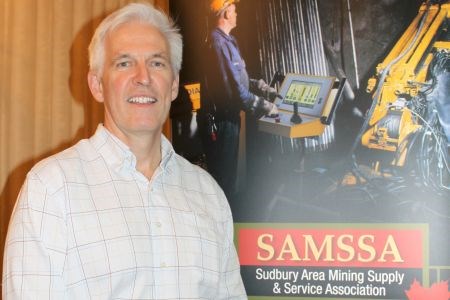By 8:30 a.m. on the day of his presentation to members of the Sudbury Area Mining Supply and Service Association (SAMSSA), Michael MacFarlane had already been up for four hours and worked for three.
As the senior vice-president of technology and innovation for AngloGold Ashanti, MacFarlane lives in Sudbury and works in South Africa, and believes the mining industry has arrived at the era of the global virtual employee.
“That's how the work gets done,” he said. “That's the future.”
To keep up with the rising demand for minerals, companies need to focus on global networking to find the expertise and innovation needed to sustain the industry, MacFarlane said.
For the last 100 years, the industry has operated using the same methods, a combination of human labour matched with heavy machinery and automation, he noted. But a higher mining intensity is needed in order to keep up with future needs, and that requires mining companies to change the way they do things.
“We cannot continue to mine the deposits we have at the rate we're mining them,” MacFarlane said. “You have to take the intensity and triple it if we have any hope of meeting the signal of what the market's looking for. The current mining methods we have, I just don't believe they're going to work in the underground context and deliver the response that the market's asking for.”
One area of concern is investment in research and development (R&D). Big companies like Boeing and IBM are spending between seven and 13 per cent of their gross revenue on R&D, while the mining industry is spending a paltry 0.2 per cent, and most of that is handed over to suppliers, MacFarlane said.
He believes R&D and innovation can more effectively be achieved by a consortium or network of global partners working together and making a collective effort to find solutions to mining's most pressing problems.
“Within the mining industry, it's who understands this first, who understands it the best and who can implement it first that wins the game,” he said. “It's about networks and managing decisions.”
MacFarlane was given this task after joining AngloGold Ashanti in 2010. He's since brought together a group of 250 people from different companies and organizations around the world working to brainstorm solutions to industry conundrums.
Through this model, MacFarlane acknowledged, there is a tradeoff between retaining intellectual property (IP) and strategic advantage. He argues the benefit is developing generic technologies that can advance the industry as a whole without giving a competitive advantage to one company over another.
“We need more R&D being done, and if we encourage and offer the IP up and even pay for some of it, you're going to get more done,” he said. “As soon as you lock it down, you're going to get less money spent. And our argument is, for the next 10 years, open it up. The industry needs a complete overhaul of the mining approach. Ten years from now lock it down, but for the time being, it's about speed. That's where the value is.”
MacFarlane also advocates the idea of borrowing to innovate: applying technology from one industry for use in another. Working in solitude is expensive and slow, he argued, but there's no reason to reinvent the wheel if applicable technology is already out there.
AngloGold wanted to develop a drill that would pinch and swell, to follow the ebb and flow of a mineral reef, and figured it would take about five years to develop, MacFarlane said. After a search, the company discovered the technology already existed and is in the process of adapting it to its purposes.
“Half of the technology that we've identified that's required to do gold on tap, which is in-situ leaching, already exists in the oil and gas industry,” he said. “You just have to go and take it and configure it for what you're doing.”
Not only does this approach leave a smaller footprint, but it also requires less capital investment, timelines are shorter, and mining intensity, the ultimate goal, is increased, he added.




